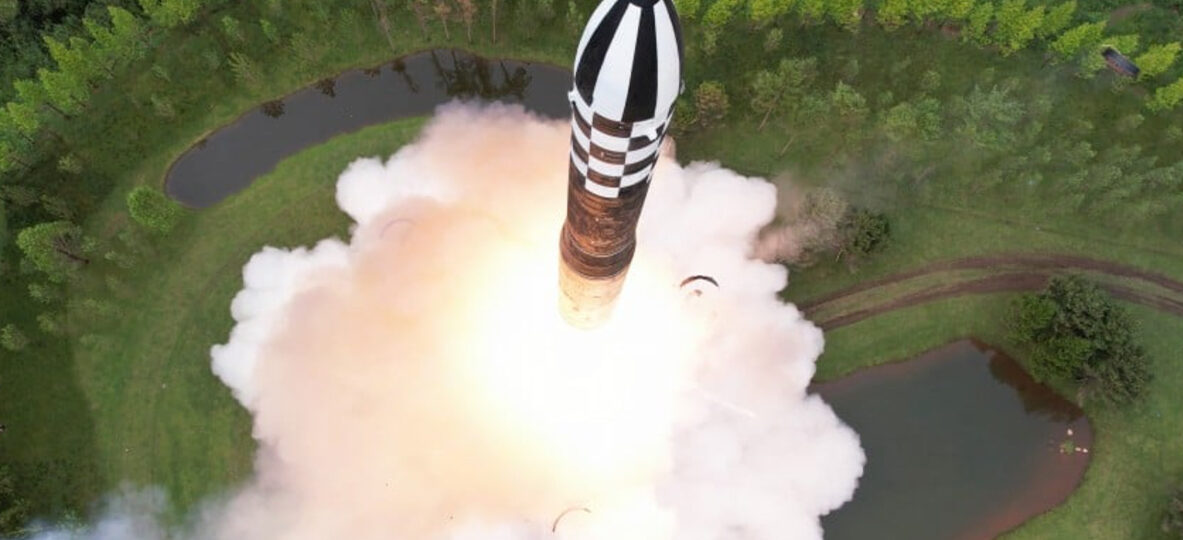Arms control advocates often propose a minimal deterrence strategy as a first step toward the abolition of nuclear weapons. Closely connected to a “no first use” policy, much of such thinking advocating these two positions flows from a mistaken view that nuclear weapons are not useful in deterring adversaries, irrelevant to new threats, and a useless tool for statecraft.
Russia’s invasion of Ukraine, terrorism, and climate change are often trotted out as examples of threats nuclear weapons cannot deter. This straw man argument fails to acknowledge that nuclear weapons were never meant to be a cure all for every strategic ill.
After establishing this false premise, arms control advocates suggest that the only use for nuclear weapons is deterring an adversary’s use of nuclear weapons. Advocates of nuclear abolition often go further and assert that nuclear weapons may, in fact, be completely useless. They argue a nuclear attack on the United States can be effectively deterred with American conventional weapons.
As an interim measure on the way to total nuclear disarmament, these advocates suggest that the United States only needs a small nuclear arsenal, seventy percent less than the current arsenal, to achieve a “minimum deterrent.”
There are three key flaws with such a policy. First, minimum deterrence undermines the credibility of the United States’ nuclear umbrella by reducing the size of the arsenal to a point that allies no long find extended deterrence credible—setting the stage for nuclear proliferation.
Second, minimum deterrence undermines the role of nuclear arms in deterring and limiting conventional conflict. Nuclear weapons do far more than simply deter the use of other nuclear weapons.
Third, minimum deterrence ignores the critical requirement for strategic stability, especially during a crisis between nuclear-armed adversaries. Too little capability can encourage an adversary to act aggressively.
In short, when it comes to strategic nuclear deterrence, size matters and numbers count. Each point deserves further examination.
Extended Deterrence
The United States extends the protection of its nuclear umbrella to over 30 allied non-nuclear nations. This includes North Atlantic Treaty Organization (NATO) member-states and helps guarantee allies are not threatened by nuclear-armed adversaries. Critical to the success of such a policy is the credibility of the American commitment to allies’ security. That requires the American deterrent to remain capable and credible.
Extended deterrence helped ensure that the Soviet Union did not threaten NATO allies with nuclear use or aggression during the Cold War. The success of extended deterrence gave American allies in NATO and Asia the confidence to sign and ratify the Nuclear Non-Proliferation Treaty (NPT). Absent a credible American nuclear arsenal, this was unlikely to occur.
Russia’s penchant for bullying non-nuclear states and territorial expansion makes extended deterrence all the more important. Arms control and nonproliferation become far more difficult when the United States lacks the capability to assure its allies. Even now, South Korea and Japan are wondering if the United States will actually come to their aid in a nuclear fight with North Korea or China.
Consequently, policy pronouncements that the United States should limit its nuclear deterrent to stopping a nuclear attack on the homeland may very well heighten President Vladimir Putin’s willingness to recklessly threaten allies and friends in Eastern Europe. And it may heighten similar threats to Japan from China given the latter’s growing nuclear arsenal and desire for a nuclear strategy similar to that of Russia and the United States.
Thus, far from reducing the role of nuclear weapons in Russian security policy, Russia is already expanding the role of nuclear weapons in its security policy, with more to follow in the years ahead. Such an altered strategic environment is very bad for extended deterrence.
Minimum deterrence divorces the United States’ nuclear deterrent from its longtime role in preventing or limiting conventional conflict. This may give a green light—however inadvertently—to those seeking to use conventional force against America’s friends and allies. In short, adversaries may believe they do not need to fear a nuclear response if the sovereignty of an ally is threatened by conventional force.
NATO member-states must naturally wonder if their membership in the alliance is sufficient to prevent Russian aggression. The corollary to this concern regards American credibility. Are American promises credible in the face of a Russian theater nuclear arsenal that is ten to thirty times larger, and far more diverse, than NATO’s nuclear arsenal. Will the Americans trade Tallin for New York?
Minimum deterrence advocates accept that Russia’s war on Ukraine is reckless aggression. They then suggest that NATO conventional capabilities can defeat future Russian aggression, even nuclear aggression, and that our nuclear weapons need not play any role. This belief may prove untrue—leaving NATO’s east flank to pay a costly price.
There may be at least four additional factors worth considering when determining whether a minimum deterrence posture will or will not work. This is particularly important when considering NATO’s conventional capabilities, which require nuclear weapons to supplement limited conventional forces.
First, NATO’s conventional force capability in Eastern Europe is insufficient to the task of deterring Russian aggression in Ukraine, Georgia, and Moldova. While these are non-NATO nations, they either border NATO member-states or were in talks with NATO concerning membership. Furthermore, some senior Norwegian defense officials warned that Russia maintains conventional superiority in the Arctic.
Although the likely outcome of the Ukraine war is unclear, the question of “what comes next” should be high on the agenda for NATO. If Moscow ends up thinking it has a green light to dismember Ukraine, even a small part, it may also think it can do the same to the Baltic states.
Second, NATO action in the war in Ukraine is not deterring further Russian aggression. It appears Russia is seeking to simply wear out Ukrainian forces and NATO resolve. Possible Russian efforts to employ such a strategy against the Baltic states, for example, should raise concerns in European capitals.
It may simply be the case that Moscow does not believe Washington is serious about stopping or reversing Russian aggression in Ukraine, irrespective of American nuclear or conventional capability. Although Ukraine is not a member of NATO, the United States and NATO called for Russian aggression to stop. Failing to ensure their objectives come to fruition sends a message to Vladimir Putin or Xi Jinping that the United States is unserious.
Third, American conventional capability is proving ineffective at deterring Russian aggression. US Strategic Command’s former commander, Admiral (Ret) Charles Richard, previously testified before Congress that American conventional plans for prevailing against an aggressor in Europe come undone if nuclear weapons are used in the conflict. Richard said, “Every operational plan in the Department of Defense, and every other capability we have, rests on an assumption that strategic deterrence will hold. And if strategic deterrence, and in particular nuclear deterrence, doesn’t hold, none of our other plans, and no other capability that we have is going to work as designed.”
Moscow may have indeed concluded just that. This leaves the United States with little more than a strategy of hope built on optimism.
Fourth, while current American nuclear and conventional forces are not stopping Russian serial aggression in Eastern Europe, future capabilities are even less likely to deter Russia or, more importantly, China. The proof of this view may come when Russia broadens its aggression to include the Baltic’s or other border areas. For China, the long-awaited invasion of Taiwan is the proof no American wants to see.
The final weakness of minimum deterrence is its impact on strategic stability. Idealist claims that today’s dangers do not match the severity of the Cold War. Allowing for more risk with a smaller arsenal is a clear misreading of the current and future strategic environment. The future is anything but predictable, which means taking less, not more, risk is the wiser course of action.
Admittedly, deterrence is not an exact science. However, the Director of National Intelligence’s public statements suggest that the threats to the United States are graver than at any point in the 45 years the intelligence community has collected threat data. By way of example, Vladimir Putin is repeatedly threatening the United States and NATO with nuclear attack, something the Soviets did not do.
Franklin Miller, a former senior Pentagon and White House nuclear policy official warned,
The triad and our targeting policy need to continue to give us confidence that we are not approaching the edge of disaster from miscalculation. For virtually every armed conflict involving US military forces since WWI, a major cause was allowing a potential adversary to miscalculate our response and our ability to respond and particularly our mistake in not being well prepared. Minimum deterrence strategies would so reduce US nuclear deterrent forces as to dramatically heighten the incentive of the world’s bad actors to pre-emptive attack the United States and take us out of the nuclear deterrent business.
Conclusion
In the end the question is whether the United States should deliberately lessen the credibility of the nation’s nuclear deterrent by the adoption of a minimum deterrence strategy as part of a hoped-for road to nuclear abolition. The logical answer is clearly no.
Winston Churchill said it best when, prior to World War II, members of parliament were advocating for restraint in British shipbuilding, he quipped, “Building slow destroyers? You might as well breed slow racehorses.” Unfortunately, the United States seems determined to follow the course of the pre-war British parliament by building a nuclear arsenal that is the equivalent of Churchill’s slow racehorse. This is a mistake.
About the Author

Peter Huessy
Mr. Peter Huessy is President of his own defense consulting firm, Geostrategic Analysis, founded in 1981, and through 2021, Director of Strategic Deterrent Studies at the Mitchell Institute on Aerospace Studies. He was the senior defense consultant at the National Defense University Foundation for 22 years. He was the National Security Fellow at the AFPC, and Senior Defense Consultant at the Air Force Association from 2011-2016.
Mr. Huessy has served as an expert defense and national security analyst for over 50 years, helping his clients cover congressional activities, arms control group efforts, nuclear armed states actions, and US administration nuclear related policy, budgets, and strategies, while monitoring budget and policy developments on nuclear deterrence, ICBM modernization, nuclear arms control, and overall nuclear modernization.
He has also covered nuclear terrorism, counterterrorism, immigration, state-sponsored terrorism, missile defense, weapons of mass destruction, especially US-Israeli joint defense efforts, nuclear deterrence, arms control, proliferation, as well as tactical and strategic air, airlift, space and nuclear matters and such state and non-state actors as North Korea, China, Iran, Syria, Venezuela and Hezbollah, Hamas, and Al Qaeda. This also includes monitoring activities of think tanks, non-governmental organizations, and other US government departments, as well as projecting future actions of Congress in this area. His specialty is developing and implementing public policy campaigns to secure support for important national security objectives. And analyzing nuclear related technology and its impact on public policy, a study of which he prepared for the Aerospace Corporation in 2019.





